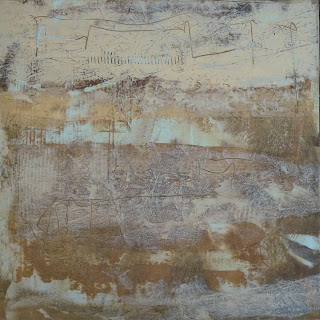I have completed four pieces since my post of November 10th, and have been very happy about them. (The image at left, as yet unnamed, is one of them, 9" x 11".) In each case, I had built up layers somewhat at random, using hues that either contrasted or complemented lower layers, and always having in mind a concept. That is, I had followed the process that I have written about in earlier posts this fall. For the top layers, following my own advice, I sought to identify techniques that would produce a pleasing visual surface. And my main concern as I worked has been at that level: How to create subtlety, how to soften edges,
when to soften edges, what value contrasts to establish, and so on. In other words, my concerns have been with techniques and visual effects. It has been a very focused time, as I have tried to establish a kind of toolbox of options that create the effects that I want. I have worked intuitively, allowing what is happening on the surface to guide me. All well and good. I have another five or six pieces ready to be completed, and I gain confidence with each one. My attitude is changing from, "oh no, will I ruin this?" to curiosity and anticipation about what will happen as I move paint around.
As the techniques become more natural to me, though, and as I begin to develop a sense of mastery over this stage of the painting process, doubts begin to arise. Are the pieces too much alike? Is it becoming too easy, so that they become trivial? Are they too abstract? Are they too representational? And so on. So far, when I stop to seriously consider one of these doubts, it is easily put to rest, either as untrue, or as something that I can easily change. For example, three of the four finished pieces have a similar final composition, with darker hues at bottom, lighter hues at top, and a patina of white blended across the whole surface, as in the image above. Are they too much alike? Or is this consistency? In either case, I just need to avoid making it a pattern that I always follow. It has been a means to achieving the end of developing a set of techniques, but it it is time to vary the pattern. So, I'll break out of it on the next piece.
Nonetheless, uneasiness remains. I realized this morning that my doubts are actually related to the fact that, for these four pieces, I did not have in mind a guiding concept as I worked on that top surface. As I become more confident in the
how of the finished layer, I need to plug in the
why. Happily, I talked about this in the post of November 10:
When I get to a final layer... I am not satisfied anymore with portraying things. I bury the fossils and the riverbeds; they are not something I want on top. Instead, I want to present something that is more amorphous -- that is, I suppose, more of a mood or an emotion. An impression. A mystery to be pondered. And yet, I want it to refer... to the constructs embodied underneath, and to my overlying theme of the geology of the land.
This means that, rather than choosing colors at random based on their relationship to the hues underneath, I need to choose a mood or message, and also relate the color and value choices to that. Similarly with the composition: quiet or active, organic or mechanical, calming or exciting, depending on what I want to say. My next challenge, then, as I continue to focus on getting to finished, is to return to the meaning of what I am creating, and let it guide which tools I choose to use from my expanding collection.
























